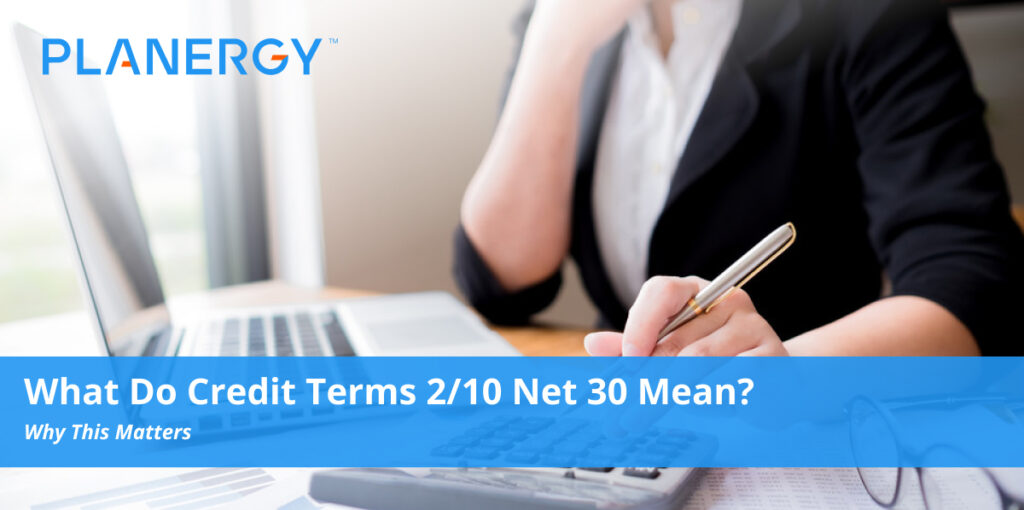What Do Credit Terms 2/10 Net 30 Mean?
Though invoices state the balance owed, more often than many realize, it’s possible to negotiate to pay less. Efficiently managing your accounts payable process means that you may be able to capture early payment discounts to help your small business save money.
An invoice states the credit terms or payment terms of a transaction, between the buyer (payer) and the seller (payee). A fairly standard credit term is net 30, which means the balance is due within 30 days of the invoice date – not when the transaction actually occurred.
What is 2/10 Net 30?
2/10 net 30 means that buyers are eligible to get a 2% discount on trade credit if the amount due is paid within 10 days. After those 10 days pass, the full invoice amount is due within 30 days without the 2% discount according to the terms for 2/0 net 30.
How to Calculate 2/10 Net 30
Take a look at this example to determine how much the credit customer pays:
Invoice full amount: $1,000
Invoice date: September 1
Invoice due date: 30 days
Payment terms: 2/10 net 30
Discount period: 10 days
Begin counting the days from the day after the invoice date.
The quick formula is 100% -discount % x invoice amount
100%-2%= 98% x $1,000 = $980
Date of Invoice Payment: September 1 through September 11 Number of Days Before Paying: 0-10 Discount 2% – Discount Amount $20 Payment Amount Due $980
Date of Invoice Payment: September 12 through October 11 Number of Days Before Paying 11-30 Discount 0% Discount Amount $0 Payment Amount Due: $1,000.
What are Trade Credits?
Trade credit is interest-free financing from a vendor. A customer pays later for billed purchases. In accounting, it is known as trade payables or accounts payable.
Vendors may include an interest rate for late payments made after the due date in the payment terms. However, suppliers may not collect the late payment finance charges on trade payables.
What is the Net Method for Trade Credit Accounting?
Record the invoice balance less discount as a single net amount. The customer records a credit purchase and accounts payable. The vendor records the credit sale and accounts receivable.
Continuing with our example from above:
$1,000 – $20 discount = $980 net amount recorded. These transactions are often automated with accounting software.
To record a purchase when a customer receives the goods:
Purchases: $980
Accounts Payable: $980
To pay the invoice included in the accounts payable balance early:
Accounts payable: $980
Cash: $980
If the company does not pay early, the entry is:
Accounts Payable: $980
Purchase Discounts: $20
Cash: $1,000
Purchase discounts is a contra account to purchases but increases purchases if not paid early.
What is the Gross Method for Trade Credit Accounting?
Record the invoice amount and discount in separate accounts. The customer tracks the total discounts taken, or the vendor tracks the discounts given. The amounts reduces purchases for buyers, or sales for sellers.
This example shows the bookkeeping for transactions for a customer purchases:
To record a purchase when the customers receives goods:
Purchases: $1,000
Accounts payable: $1,000
To pay the invoice included in the accounts payable balance early:
Accounts Payable: $1,000
Early payment discounts on purchases: $20
Cash: $980
The early payment discount account is a contra account that reduces purchases.
From the seller’s side:
The seller will initially record sales and accounts receivable at the total amount. If the customer pays early, the seller records the sales discount as a debit in the sales contra account known as sales allowances. Sales allowances reduce sales in the income statement.
What are Buyer-Initiated Early Payment Programs?
A buyer initiated early payment program is managed through accounts payable, using either the supply chain finance method or the dynamic discounting method.
If the seller doesn’t offer cash discounts upfront, the buyer can negotiate an early payment discount. If the buyer suggests a beneficial officer, the seller accelerates their cash flow if they accept. Buyers reduce spending.
Supply Chain Method
Using the supply chain finance method, buyers borrow funds from a trade credit financier to pay the invoice under the terms of the early payment. The buyer pays back the third party, as this method is basically a loan. This finance technique offers flexibility when cash balances are low, but buyers want to avoid using a credit card because of high interest rates.
Dynamic Discounting Method
With dynamic discounting, the buyers initiate an early payment offer on an invoice-by-invoice basis, where the discount varies. The buyer may offer a 2% discount to one seller and a 1.5 percent discount to another. Buyers who use this approach can leverage their excess cash.
Other Trade Terms
Here are some payment terms on vendor and supplier invoices that are defined in a similar way:
- 2/10 net 45: 2% early payment discount within 10 days, or the total amount of the invoice due in 45 days.
- 3/10 net 30: 3% early payment discount within 10 days, or the total amount of the invoice due in 30 days.
- 3/20 net 60: 3% early payment discount within 20 days, or the total amount of the invoice due in 60 days.
- 2/EOM net 45: 2% early payment discount if paid by the end of the month or total amount due in 45 days.
- Net 20 EOM: The total amount is due for full payment within 20 days after the end of the month.
On credit sales, vendors often a 2% discount most often. Some vendors will charge finance charges or interest on overdue bills according to their invoice terms.
When it comes to implementing an early payment program, using either the supply chain finance method or the dynamic discounting method, organizations often find that it is easier said than done. The issue lies in how efficient the accounts payable workflow is. Businesses that rely on manual accounts payable processes will run into some common challenges regarding early payment discounts:
- Weak Buyer-Seller Relationship: For an early payment discount program to work, both buyers and sellers must adopt it. Building the relationship between buyer and seller takes time, and can be a challenge if contact only takes place when the client is onboarded and when tax documents are submitted. The lack of real-time visibility into payment status hinders a buyer’s ability to provide an accurate timeframe for delivery payment. This can affect the seller’s attitude and trust in participating in an early discount program.
- Lengthy Invoice Approval Process: The amount of time between receiving the invoice to approving the invoice is oftentimes outside the timeframe of 2/10 net 30, which prevents the buyer from taking advantage of the discount.
- Lack of Data: The buyers have to negotiate discount terms that are attractive to the seller that makes a difference in the profit margin. The discount has to be mutually beneficial. Finding the sweet spot takes visibility into multiple variables, such as: discounting liquidity constraints, third-party financing availability, buyer hurdle rate, and more. Manual accounts payable processes make it hard to see the data necessary for these variables, across all vendors.
When to Use the Early Payment Discount
Early payment discounts make sense for buyers with access to a line of credit or supply chain financing, or those that have cash balances. Buyers need to compare any interest rates to the opportunity cost of not taking the discount. The seller receives cash and collects accounts receivable faster when the customer pays early, but it doesn’t make sense for all customers to pay early when they can pay on time and keep that working capital free in the meantime.




